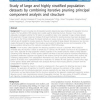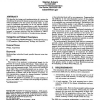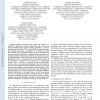182 search results - page 6 / 37 » On the Simulation of Large Populations of Neurons |
BMCBI
2011
12 years 11 months ago
2011
Background: The ever increasing sizes of population genetic datasets pose great challenges for population structure analysis. The Tracy-Widom (TW) statistical test is widely used ...
SAC
2002
ACM
13 years 7 months ago
2002
ACM
We describe the design and implementation of a system for simulating the spread of disease among individuals in a large urban population over the course of several weeks. In contr...
NECO
2010
13 years 2 months ago
2010
Temporal derivatives are computed by a wide variety of neural circuits, but the problem of performing this computation accurately has received little theoretical study. Here we sy...
AINA
2010
IEEE
13 years 11 months ago
2010
IEEE
—Mnesic evocation occurs under the action of a stimulus. A successful evocation is observed as the overrun of a certain threshold of the neuronal activity followed by a medical i...
IAT
2008
IEEE
14 years 2 months ago
2008
IEEE
Within Criminology, the process of crime displacement is usually explained by referring to the interaction of three types of agents: criminals, passersby, and guardians. Most exis...



